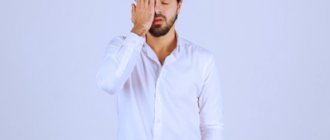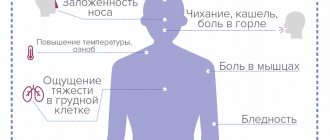Every person periodically faces severe fatigue, when the only desire left is to fall and pass out, and any obstacle on the way to the desired rest causes an attack of irritation. But once you get enough sleep, your body is alert again, and life is full of colors. However, sometimes the scenario “tired - rested - cheerful and active again” is disrupted: sleep is not refreshing, strength flows away like water into sand, the reaction to others becomes more and more nervous.
Such a constant feeling of weakness and lethargy, combined with irritability, signals that a person has developed neurasthenia. Why does she appear? How to cope with this disease? Let's figure it out.
What is neurasthenia?
This is a disorder of the nervous system, which is caused by depletion of the body's strength. It manifests itself as a reduced ability to engage in mental and/or physical activity.
According to WHO, about 10% of the population of developed countries need treatment for neurasthenia. Women suffer from this disease 2–3 times more than men. This disease occurs both among people of working age and among elderly and elderly people.
Causes
- Prolonged stay in a situation where a person is required to constantly and excessively exert mental and/or physical strength.
- Congenital features of the nervous system are rapid fatigue, long-term restoration of energy reserves.
- Increased personal anxiety with a desire for perfection, hence excessive zeal in fulfilling work or family responsibilities.
- Physical limitations - chronic lack of sleep, fasting, lack of rest, etc.
- Menopause in women (the disease occurs in 13% of those who have reached menopause).
Symptoms
The main sign of neurasthenia is catastrophically rapid fatigue, both mental and physical, against a background of increased irritability. It occurs even after very light loads. A person, after working for just a few minutes, feels overwhelmed, weak, and unable to continue activities.
What other symptoms are inherent in this disease?
Increased irritability
A person lashes out at children, relatives, colleagues, strangers. Moreover, the reasons can be very minor, and the reaction can be very violent (screaming, throwing objects).
Sensitivity to physical stimuli
The patient reacts negatively to minor phenomena - dim light, quiet sounds (for example, the rustling of a newspaper or drops outside the window). It is difficult for him to tolerate cold or elevated air temperatures.
Increased tearfulness
The slightest reason can cause sobs, even if the person was not previously sentimental and sensitive.
Absent-mindedness
It is difficult for the patient to concentrate on some object or action, it is difficult for him to remember something, but he forgets everything very quickly.
Insomnia
It is difficult to fall asleep due to disturbing thoughts; a person gradually develops a fear of not falling asleep. This makes sleep problems worse.
Morning weakness
Even with enough time to sleep, a person does not feel fresh and energetic in the morning.
Constantly feeling tired
It applies to both physical and mental well-being.
Headaches, dizziness
Often there is “helmet syndrome” - a feeling that the head is being squeezed from above and from the sides.
Painful sensations throughout the body
This may include muscle pain, stomach cramps, sweating, breathing problems, frequent urination, etc.
The term “neurasthenia” was first introduced by the American physician Beard in 1869. Translated from Greek, this word means “nervous weakness.”
Forms of the disease
The disease has three forms (they are also stages: form and stage are not the same thing; in this case we are talking about different forms of the disease) of the process. They differ in the severity of symptoms.
- Hypersthenic. The patient quickly becomes irritated by the conversations of others, being in a crowd, communicating with people. His performance is reduced, partly due to fatigue, but mostly due to absent-mindedness and inability to concentrate. A person experiences problems sleeping and feels discomfort in different parts of the body. At this stage, neurasthenia can be treated quite simply, but if adequate therapy is not carried out, the situation worsens.
- Irritable weakness. A person suffers from increased anger, which is combined with rapid exhaustion. This manifests itself in violent outbursts at the slightest provocation. Such attacks occur quite often, but each of them is short-lived and ends with a loss of strength. The patient does not control the manifestation of his emotions. Also, discomfort in the body increases, appetite disappears, and disorders in the sexual sphere appear.
- Hyposthenic. In this form of the disease, the predominant symptom is exhaustion. A person constantly experiences weakness, drowsiness, and loss of strength. Any activity is rejected because it seems too exhausting. The discomfort in the body is strong, so the patient spends a lot of time thinking about these symptoms. Hence the depressed mood, sadness, and tearfulness.
Reviews about the treatment of neurasthenia
Svetlana Pavlova, 33 years old: My “acquaintance” with the diagnosis of neurasthenia began when I lost a loved one. At first there was something like depression. Then it turned into aggression, and gradually, I just began to fade away. I did self-medication for about six months, taking valerian, peony and motherwort tinctures. There was some effect, but there was nothing significant to speak of. Only a psychotherapist really helped me. She took a course of tranquilizers and a vitamin complex. Training with a specialist helped a lot. Everything is written correctly: it is important to find the reason that led to neurosis
Alesya Makarova, 28 years old: After the birth of my child, I completely lost my vital energy. Everything just turned upside down. It got to the point where my brain was turning off. She could even scream at an infant because he was screaming. Absolute loss of strength. I took vitamins for nursing mothers. Many people wrote that you need to drink magnesium. But only a psychotherapist helped me, finding me a really effective way to deal with the disease. I took sedatives on a natural basis (some herbs). Plus I was recommended to take a warm bath with aromatic oil. I visited a massage therapist and started doing yoga.
How to treat?
Advice to “calm down”, “pull yourself together”, “get off the couch and do something useful” and others in the same spirit will not help a neurasthenic. After all, the point is not in defects in upbringing or lack of motivation for activity, but in the special state of the nervous system. And only a doctor who understands the treatment of neurasthenia, both medicinal and psychotherapeutic, can help here.
- First of all, it is necessary to establish a daily routine with sufficient time for sleep at night and rest during the day, as well as organize proper nutrition.
- In case of severe exhaustion, treatment is prescribed with release from work and bed rest.
- To reduce the patient's excitability and irritability, relaxation techniques are taught and psychotherapeutic conversations are conducted.
- To support the body, vitamin and mineral complexes are prescribed (in particular, with B vitamins and magnesium).
- To calm and improve sleep, the doctor may include sedatives and “light” tranquilizers in the treatment plan for neurasthenia.
- For serious problems with memorization and concentration on mental actions, nootropic drugs are prescribed (they stimulate memory, attention, and thinking).
- If the disease is severe and combined with signs of depression and anxiety disorder, then antidepressants and “classic” tranquilizers, and in some cases antipsychotics, are prescribed.
Important: only a doctor should assess the patient’s condition with neurasthenia and prescribe medications. Uncontrolled use of medications can significantly worsen the situation - deepen exhaustion, disrupt the functioning of various body systems.
Today, to improve the results of therapy, doctors recommend Selank, a new generation remedy with a wide spectrum of action.
Treatment of neurasthenia at home
Treating neurasthenia at home is quite possible. But, unfortunately, according to the observations of our psychiatrists, providing assistance at home is not always effective.
To reduce the symptoms of a mental disorder at home, you can:
- taking sedatives;
- aromatherapy;
- massage;
- creating a menu with a high content of calcium and magnesium;
- walks in the open air;
- drinking herbal teas (valyana, motherwort, etc.).
Yoga can also help reduce the symptoms of the disease. You can perform the exercises with a personal trainer or on your own at home.
With a course of treatment, you can see positive results. However, don't get carried away. If nervous tension, insomnia and loss of strength do not leave you, you should immediately seek help from experienced specialists. Self-medication can cause irreparable harm to your body.
What is Selank?
The human body produces a special peptide - tuftsin, which supports the immune system, and also improves mental activity and relieves anxiety. But it is destroyed quite quickly and, as a result, if there are problems with the nervous system, it does not have time to put the person’s emotional sphere in order.
Selank is a synthetic tuffin, enhanced with three amino acids to prevent rapid breakdown. It is released in the form of nasal drops. This form helps the product have a very rapid effect: the substance is absorbed by the nasal mucosa, penetrating through the olfactory nerves directly into the brain tissue. And there it immediately becomes involved in the processes of regulating emotions and improving cognitive functions.
Academician of the Russian Academy of Sciences Nikolai Myasoedov, one of the creators of this peptide solution: “Selank is based on a substance present in our body, so the body is reliably protected from its overdose.”
Selank combines the properties of an anxiolytic (anti-anxiety drug), an antidepressant, a nootropic (increasing memory, attention and intelligence) and an antiasthenic (restoring mental functions and physical performance) agent. At the same time, it is not addictive, drug dependent and does not have a negative effect on the body.
When is Selank used?
- For nervous exhaustion, lethargy, weakness
- To help with stress conditions
- For difficulties falling asleep, interrupted sleep, insomnia
- For the treatment of psycho-emotional disorders, including neurasthenia, during menopause in women
- In cases of frequent mood swings
- If you have problems with adaptation
- In the presence of unreasonable anxiety and worry
- To relieve signs of depression
Irritable weakness
This condition is an intermediate stage between the hypersthenic and hyposthenic phases. It is formed in people with a balanced type of nervous system, with a choleric expressive temperament, after they have passed the hypersthenic phase and lack of proper treatment.
At this stage, the neurasthenic is characterized by the opposite of symptoms. For example, irritability abruptly gives way to apathy. The patient quickly gets wound up, begins to scream, and then sharply the excitability gives way to inhibition. He feels exhausted, feels resentment and despair, and is able to cry, even if this was unusual for him before.
Other features inherent in this state include fussiness, impatience, and lack of control over one’s own emotions. Absent-mindedness and memory problems appear.
Sleep is superficial, with difficulty falling asleep. You feel drowsy during the day, followed by insomnia at night. Sleep does not fulfill its intended purpose - rest, relaxation, restoration. Upon waking up, people with neurasthenia are deprived of vigor and a surge of energy.
Gradually, the condition moves into the next stage, when you “give up,” you don’t want to do anything, and it’s difficult to concentrate. When starting to perform any work, the patient quickly gets tired, loses clarity of perception, and his headaches intensify. Because of the weakness he experiences, he abandons the work he has begun, while feeling annoyed at his own powerlessness. After some time, he again tries to do something and again gives up due to the same exhaustion.
In the intervals between such stages, energy and mental balance are not restored. Their numerous repetitions pretty much exhaust the patient, leading to complete exhaustion. There is a fixation on bodily sensations. There is a belief in the presence of diseases of the internal organs, based on the experienced vegetative symptoms. The extreme degree of the condition is the appearance of depressive motives in behavior: gloom, lethargy, indifference.
How Selank works
The mechanism of the positive therapeutic effect of Selank is based on its ability to restore normal levels of monoamines (serotonin and norepinephrine) and enkephalins in the emotiogenic centers of the brain (limbic system). Based on the results of medical studies involving men and women of different ages who need treatment for neurasthenia, Selank works like this:
- helps reduce fatigue during exercise and reduce anxiety;
- has a positive effect on mood, well-being and activity;
- helps increase endurance during intellectual and physical activity;
- helps solve sleep problems;
- helps reduce attacks of irritability;
- helps alleviate the somatic manifestations of neurasthenia - headaches and discomfort in the body.
In this case, positive changes occur within 1-3 days from the start of taking the peptide solution, continue to increase for 2-4 weeks after the end of the course of taking it and persist for at least another 1-3 months.
General symptoms of the disorder
Asthenic neurosis can manifest itself in the following forms:
- hypersthenic;
- hyposthenic;
- irritable weakness.
Each of them is accompanied by its own symptom complex, but there are signs of the disease that are common to all types:
- headache;
- dizziness;
- sleep disorder;
- malaise;
- poor memory;
- diffidence;
- somatic disorders.
The headache usually increases towards the end of the day and is vague in nature. There is a feeling of compression of the head, as if a massive helmet is being put on it. The phenomenon was called the “neurasthenic helmet.”
Dizziness is manifested by a feeling of rotation inside, but not surrounding objects. It often accompanies situations involving physical fatigue, increasing anxiety, and changes in weather.
Common somatic symptoms include:
- sensation of accelerated heartbeat;
- rapid pulse;
- hypertension;
- pallor, facial hyperemia;
- pain in the chest of a pressing, stabbing nature;
- constipation, diarrhea;
- gas formation, heartburn, heaviness in the stomach;
- increased sweating;
- feeling of heat in the body;
- chills;
- increased urge to urinate during emotional stress, normalization of the state at rest;
- sexual dysfunction: premature ejaculation, impotence, anorgasmia, frigidity.
Somatic disorders can occur in isolation or in combination unexpectedly, at any time, especially at times of mental stress.
The mechanism of development of somatic symptoms is associated with a restructuring of higher nervous activity. When the brain is exposed to a negative factor for a long time or sharply with high intensity, the first, in order to increase the body’s resistance, is rebuilt, making adjustments to the activity of the nervous system. In the GNI, a dominant is formed that directs the brain to fight or ignore the damaging factor.
The work of internal organs is regulated by the nervous system, where a special role is played by the balance between the processes of excitation and inhibition. An imbalance in their interaction leads to disruptions in the proper functioning of the nervous system, as a result of which the organs receive erroneous signals that disrupt their functioning. First of all, the most vulnerable organ “loses ground”, which already had functioning problems before exposure to the stress factor.
It is important to distinguish between neurasthenic and ordinary physiological fatigue. The latter occurs as a result of excessive physical or mental stress, disruption of work and rest schedules, and changes in climatic zones. Physiological fatigue develops once and disappears after sufficient rest. Neurasthenic fatigue develops gradually and does not go away even after a long rest.
Pros of Selank
This remedy has a number of qualities that distinguish it favorably from the cohort of other, long-established anxiolytics, antidepressants, and nootropics:
- does not have any significant side effects;
- has virtually no contraindications (only age under 18 years, pregnancy, breastfeeding and intolerance to components);
- does not cause drowsiness, absent-mindedness, or difficulty concentrating;
- can be used when driving a vehicle;
- goes well with any medications that affect the psyche and nervous system;
- does not cause dependence or addiction;
- has a stimulating effect on cognitive functions (thinking, memory, attention).
Due to the high effectiveness and safety of Selank, it is available without a prescription, and doctors include it in various treatment regimens for neurasthenia in women and men, especially in the presence of signs of other neurological disorders - depression, anxiety, adaptation disorders, etc.
Ask a question | Where to buy | Scientific publications
Diagnostic features
If signs of neurasthenia appear, it is important to consult a doctor in order to make an accurate diagnosis and exclude pathologies with a similar clinical picture.
Diagnosis is based on the patient’s complaints, anamnesis, and conversation. It is important to pay attention to the somatic condition, as well as the person’s “drug” or “alcohol” history, since neurasthenia may be a consequence of intoxication of the body with the breakdown products of drugs/ethanol.
Sometimes we are talking about chronic fatigue syndrome, and the approach to its treatment is somewhat different from the treatment of neurasthenia. A good specialist will also differentiate the disorder from organic brain lesions, which is possible with the help of modern hardware diagnostic methods.
If the need arises, the psychiatrist will refer a therapist or specialists for consultation. Thus, with pronounced cardiovascular manifestations, an examination by a cardiologist may be required; if thyroid disease is suspected, a consultation and examination with an endocrinologist may be required. A gastroenterologist will help correct digestive disorders and gastrointestinal tract functions.
When treating neurasthenia, chronic infections should be excluded.
general characteristics
As we have already indicated above, in modern psychiatry there is no such concept as “neurosis”. More often, this group of diseases is currently called neurotic disorders. Among them, there is one form that occurs relatively more often than others - neurasthenia. The term “neurasthenia” was introduced into medical vocabulary in 1860 by US physician George Byrd. It was then, during the period of rapid development of capitalism, that a wave of disorders associated with chronic fatigue of patients swept across the United States. Oddly enough, the problems of the 19th century are still relevant in our time - people continue to “chase” the same values of life (finance, real estate), forgetting about rest and relaxation.
Neurasthenia is a form of neurotic disorders that is characterized by a combination of high excitability, irritable weakness, disorders of the autonomic system and increased nervous exhaustion.








